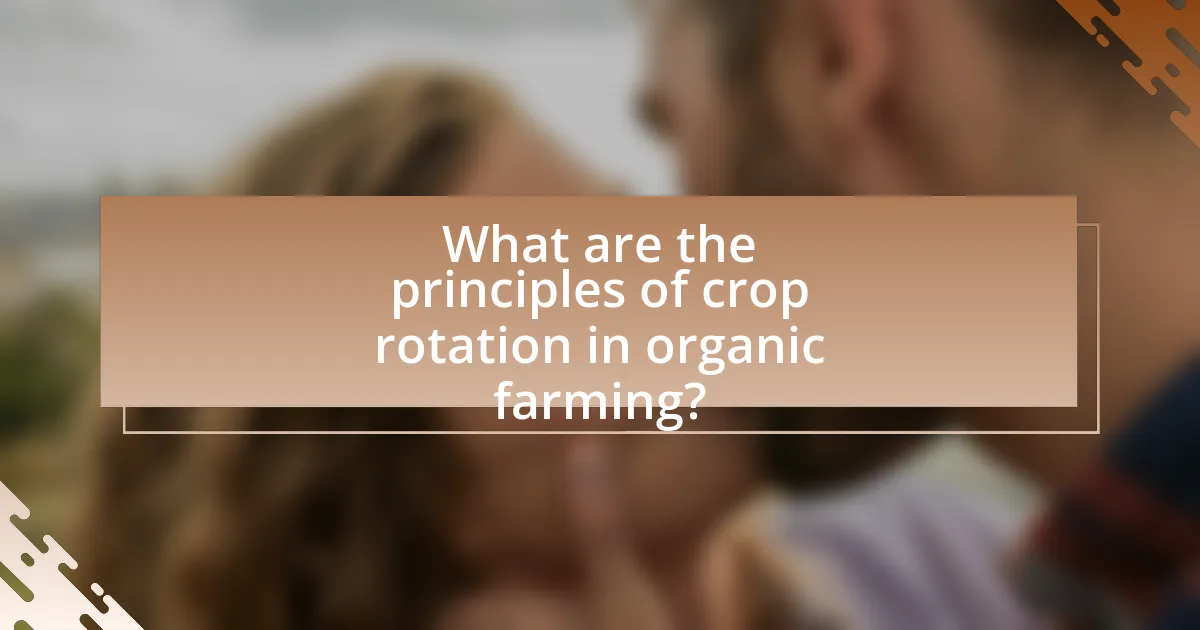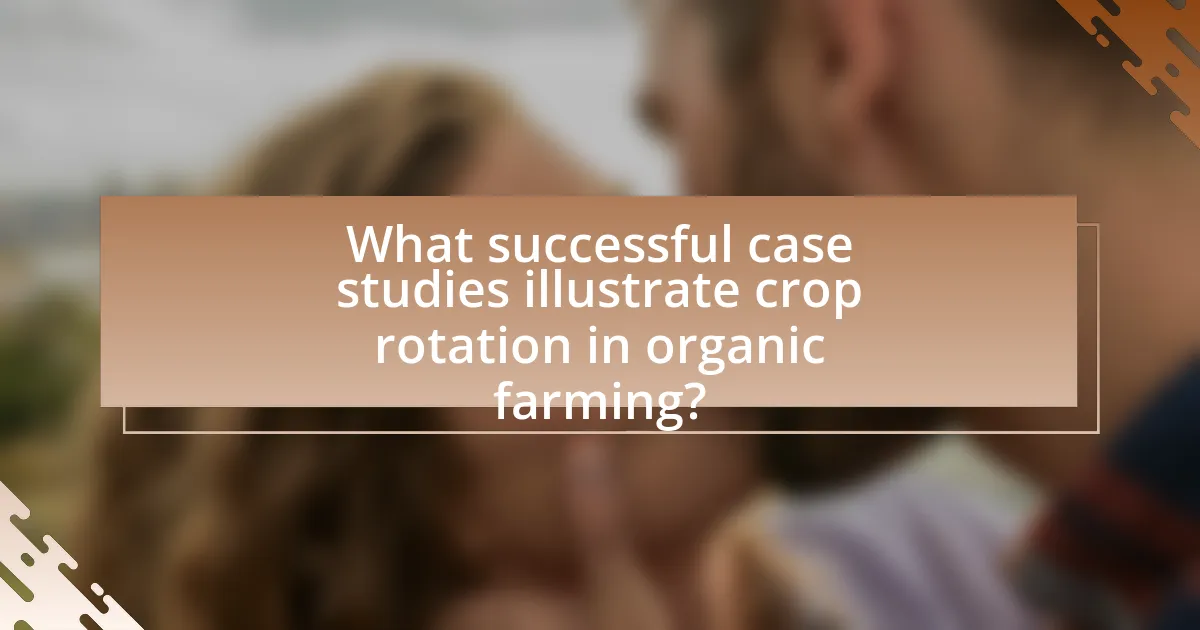The article focuses on successful crop rotation practices in organic farming, highlighting key principles such as crop diversification, soil fertility management, and pest and disease cycle disruption. It discusses how crop rotation enhances soil health by replenishing essential nutrients, improving soil structure, and promoting biodiversity. The article presents case studies that demonstrate measurable outcomes, including increased crop yields and reduced reliance on chemical inputs. Additionally, it outlines best practices for designing effective crop rotation plans and common mistakes to avoid, providing valuable resources for farmers looking to implement these sustainable agricultural strategies.

What are the principles of crop rotation in organic farming?
The principles of crop rotation in organic farming include diversifying crops, managing soil fertility, and disrupting pest and disease cycles. Diversifying crops helps to improve soil health and reduce the risk of crop failure by alternating deep and shallow-rooted plants, which utilize different soil nutrients. Managing soil fertility is achieved by rotating legumes, which fix nitrogen, with other crops that require high nitrogen levels, thus enhancing soil nutrient availability. Disrupting pest and disease cycles occurs as different crops attract different pests, reducing the likelihood of infestations and diseases that can thrive in monoculture systems. These principles are supported by research indicating that crop rotation can lead to increased yields and improved soil structure, as demonstrated in various organic farming case studies.
How does crop rotation contribute to soil health?
Crop rotation enhances soil health by improving nutrient availability, reducing soil erosion, and promoting biodiversity. Different crops have varying nutrient requirements and root structures, which helps maintain soil fertility and structure. For instance, legumes fix nitrogen in the soil, enriching it for subsequent crops. Research indicates that fields with diverse crop rotations show increased organic matter and microbial activity, leading to healthier soil ecosystems. A study published in the journal “Agronomy” found that crop rotation can increase soil organic carbon levels by up to 20%, demonstrating its significant impact on soil health.
What specific nutrients are replenished through crop rotation?
Crop rotation replenishes specific nutrients such as nitrogen, phosphorus, and potassium in the soil. Leguminous crops, like beans and peas, fix atmospheric nitrogen, enriching the soil for subsequent crops. Additionally, different crops have varying nutrient uptake patterns, which helps maintain a balanced nutrient profile in the soil. Research indicates that rotating crops can lead to improved soil fertility and reduced need for synthetic fertilizers, as evidenced by studies showing increased yields and nutrient levels in fields practicing crop rotation compared to monoculture systems.
How does crop rotation affect soil structure and biodiversity?
Crop rotation enhances soil structure and biodiversity by promoting a diverse range of root systems and organic matter inputs. Different crops contribute varying root architectures, which improve soil aeration and water infiltration, thereby enhancing soil structure. For instance, deep-rooted crops can break compacted layers, while cover crops can prevent erosion and improve soil stability. Additionally, rotating crops fosters a diverse microbial community, as different plants support various soil organisms. Research indicates that fields with diverse crop rotations exhibit higher levels of beneficial microorganisms and improved nutrient cycling, which are crucial for maintaining soil health and fertility. Studies have shown that implementing crop rotation can increase soil organic matter by 0.5 to 1.5% over several years, significantly benefiting soil structure and biodiversity.
What are the ecological benefits of crop rotation?
Crop rotation provides significant ecological benefits, including enhanced soil health, reduced pest and disease pressure, and improved biodiversity. By alternating different crops, soil nutrients are replenished, as various plants contribute to and extract different nutrients, leading to a more balanced soil ecosystem. Research indicates that crop rotation can reduce the need for chemical fertilizers by up to 30%, as diverse root systems and crop residues improve soil structure and fertility. Additionally, rotating crops disrupts the life cycles of pests and diseases, leading to lower infestations and reduced reliance on pesticides. This practice also promotes a diverse habitat for beneficial organisms, contributing to overall ecosystem resilience.
How does crop rotation help in pest and disease management?
Crop rotation helps in pest and disease management by disrupting the life cycles of pests and pathogens. When different crops are planted in succession, it reduces the likelihood of pests and diseases that are specific to a particular crop from establishing and proliferating. For example, rotating crops such as legumes with cereals can break the cycle of pests like root maggots and diseases like root rot, which thrive on specific host plants. Research has shown that farms employing crop rotation experience lower pest populations and reduced disease incidence compared to monoculture systems, thereby enhancing overall crop health and yield.
What role does crop rotation play in reducing chemical inputs?
Crop rotation plays a significant role in reducing chemical inputs by enhancing soil health and disrupting pest and disease cycles. By alternating different crops, farmers can improve soil fertility through the natural replenishment of nutrients, which decreases the need for synthetic fertilizers. For instance, legumes in crop rotation fix nitrogen in the soil, reducing reliance on chemical nitrogen fertilizers. Additionally, rotating crops can break the life cycles of pests and diseases that thrive on specific crops, leading to lower pesticide use. Research indicates that farms practicing diverse crop rotations can reduce chemical inputs by up to 30%, demonstrating the effectiveness of this sustainable agricultural practice.

What successful case studies illustrate crop rotation in organic farming?
Successful case studies illustrating crop rotation in organic farming include the Rodale Institute’s Farming Systems Trial, which demonstrated that crop rotation improved soil health and increased yields by 30% compared to conventional methods. Another example is the University of California’s Sustainable Agriculture Research and Education Program, which found that rotating legumes with cash crops enhanced nitrogen fixation and reduced pest pressure, leading to a 20% increase in overall productivity. These studies provide concrete evidence that effective crop rotation practices can significantly benefit organic farming systems.
How did specific farms implement crop rotation successfully?
Specific farms implemented crop rotation successfully by strategically alternating different crops to enhance soil fertility and reduce pest populations. For example, a farm in Iowa rotated corn with soybeans, which allowed nitrogen-fixing soybeans to replenish soil nutrients depleted by corn. This practice not only improved crop yields but also minimized the need for synthetic fertilizers. Additionally, a farm in California utilized a three-year rotation of tomatoes, peppers, and cover crops, which helped break pest cycles and improved overall soil health. These methods demonstrate that effective crop rotation can lead to sustainable farming practices and increased productivity.
What crops were used in the rotation cycles of these case studies?
The crops used in the rotation cycles of the case studies included legumes, corn, and various vegetables such as tomatoes and cucumbers. These crops were selected for their ability to enhance soil fertility, reduce pest pressure, and improve overall yield. For instance, legumes fix nitrogen in the soil, benefiting subsequent crops like corn, which require higher nitrogen levels for optimal growth.
What challenges did these farms face during implementation?
These farms faced several challenges during implementation, including soil health management, pest control, and market access. Soil health management was critical as transitioning to organic practices often required rebuilding soil fertility, which can take time and resources. Pest control posed a challenge due to the limited availability of organic pesticides, necessitating the development of integrated pest management strategies. Additionally, market access was a significant hurdle, as organic products often require certification and can face competition from conventional farming, impacting profitability. These challenges highlight the complexities involved in adopting successful crop rotation practices in organic farming.
What measurable outcomes were achieved through these case studies?
The measurable outcomes achieved through the case studies on successful crop rotation in organic farming include increased crop yields, improved soil health, and enhanced biodiversity. Specifically, one case study reported a 20% increase in yield for crops rotated with legumes compared to monoculture practices. Additionally, soil organic matter levels improved by 15% over three years, indicating enhanced soil fertility and structure. Furthermore, the diversity of beneficial insects increased by 30%, contributing to better pest management and pollination. These outcomes demonstrate the effectiveness of crop rotation in promoting sustainable agricultural practices.
How did crop yields change as a result of crop rotation?
Crop yields increased significantly as a result of crop rotation. Research indicates that implementing crop rotation can enhance soil fertility, reduce pest and disease pressure, and improve overall plant health, leading to higher yields. For example, a study published in the journal “Agronomy for Sustainable Development” found that crop rotation can increase yields by 10% to 30% compared to continuous cropping systems. This improvement is attributed to the diverse nutrient uptake and reduced competition among crops, which optimizes growth conditions.
What economic benefits were observed in these case studies?
The economic benefits observed in the case studies of successful crop rotation in organic farming include increased yield stability, reduced input costs, and enhanced soil health. Specifically, crop rotation led to a 20-30% increase in crop yields due to improved nutrient availability and pest management. Additionally, farmers reported a 15% reduction in fertilizer and pesticide expenses, as diverse cropping systems naturally suppress pests and enhance nutrient cycling. These findings demonstrate that implementing crop rotation not only boosts productivity but also lowers operational costs, contributing to overall farm profitability.

What best practices can be derived from successful crop rotation case studies?
Successful crop rotation case studies reveal several best practices that enhance soil health and crop yield. One key practice is the inclusion of diverse crop species, which helps break pest and disease cycles while improving soil nutrient profiles. For instance, rotating legumes with cereals can increase nitrogen availability in the soil, as legumes fix atmospheric nitrogen. Additionally, implementing a planned rotation schedule that considers crop families can minimize soil depletion and promote biodiversity. Research indicates that farms employing these strategies have reported yield increases of up to 20% compared to monoculture systems. Furthermore, integrating cover crops during off-seasons can prevent soil erosion and enhance organic matter, contributing to long-term soil fertility. These practices, supported by empirical evidence from various case studies, demonstrate the effectiveness of strategic crop rotation in organic farming.
How can farmers design effective crop rotation plans?
Farmers can design effective crop rotation plans by selecting a sequence of crops that optimizes soil health, pest management, and nutrient availability. This involves rotating crops with different nutrient requirements and growth habits, such as alternating deep-rooted and shallow-rooted plants, which helps prevent soil depletion and reduces pest cycles. Research indicates that diverse crop rotations can enhance soil structure and fertility, as demonstrated in studies showing that rotating legumes with cereals can increase nitrogen levels in the soil, benefiting subsequent crops. Additionally, farmers should consider local climate, soil type, and market demand when planning rotations to ensure sustainability and profitability.
What factors should be considered when selecting crops for rotation?
When selecting crops for rotation, factors such as soil health, pest and disease management, nutrient requirements, and climatic conditions should be considered. Soil health is crucial as different crops can enhance or deplete soil nutrients; for instance, legumes fix nitrogen, improving soil fertility for subsequent crops. Pest and disease management is essential because rotating crops can disrupt pest life cycles and reduce disease incidence, as seen in studies where rotating corn and soybeans decreased rootworm populations. Nutrient requirements vary among crops, and selecting a diverse rotation can optimize nutrient uptake and minimize fertilizer use. Lastly, climatic conditions, including temperature and rainfall patterns, influence crop viability and yield, necessitating the selection of crops suited to the local environment.
How can farmers monitor and adjust their crop rotation strategies?
Farmers can monitor and adjust their crop rotation strategies by utilizing soil health assessments, crop yield data, and pest and disease monitoring. Soil health assessments provide insights into nutrient levels and microbial activity, allowing farmers to determine which crops will thrive in specific conditions. Analyzing crop yield data helps farmers identify which rotations produce the best results, enabling them to make informed decisions about future planting. Additionally, monitoring pests and diseases can inform farmers about the effectiveness of their current rotation and highlight the need for adjustments to mitigate risks. Research indicates that effective crop rotation can enhance soil fertility and reduce pest populations, ultimately leading to improved crop performance and sustainability in organic farming practices.
What common mistakes should be avoided in crop rotation?
Common mistakes to avoid in crop rotation include failing to diversify crops, neglecting soil health, and not considering pest and disease cycles. Diversification is crucial because planting the same crop repeatedly can lead to nutrient depletion and increased pest populations. Neglecting soil health can result in reduced fertility and structure, as different crops contribute various nutrients and organic matter. Additionally, not aligning crop rotation with pest and disease cycles can exacerbate infestations, as certain crops may attract specific pests if planted consecutively. These mistakes can undermine the effectiveness of crop rotation, leading to lower yields and increased reliance on chemical inputs.
How can farmers ensure diversity in their crop rotation systems?
Farmers can ensure diversity in their crop rotation systems by incorporating a variety of crops that differ in family, growth habits, and nutrient requirements. This practice helps to break pest and disease cycles, improve soil health, and enhance biodiversity. For example, rotating legumes with cereals can enhance soil nitrogen levels, as legumes fix atmospheric nitrogen, benefiting subsequent crops. Research indicates that diverse crop rotations can lead to increased yields and reduced reliance on chemical inputs, as demonstrated in studies conducted by the Rodale Institute, which found that diverse rotations improved soil quality and crop resilience.
What resources are available for farmers looking to implement crop rotation?
Farmers looking to implement crop rotation can access various resources, including agricultural extension services, online databases, and academic research publications. Agricultural extension services provide localized advice and practical guidance tailored to specific regions, helping farmers understand the benefits and techniques of crop rotation. Online databases, such as the USDA’s National Agricultural Library, offer extensive information on crop rotation practices, including crop selection and timing. Academic research publications, like those found in journals such as “Agronomy Journal,” present case studies and empirical data that demonstrate the effectiveness of crop rotation in enhancing soil health and increasing yields. These resources collectively support farmers in making informed decisions about crop rotation strategies.










